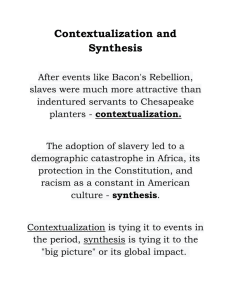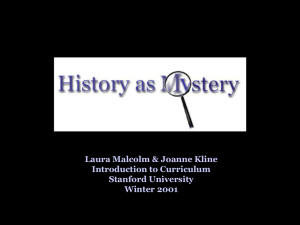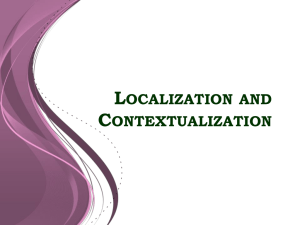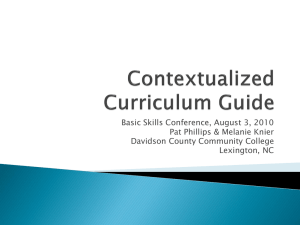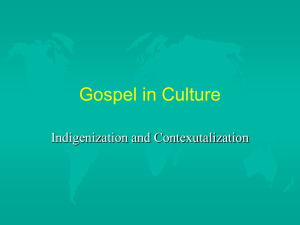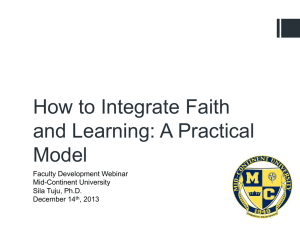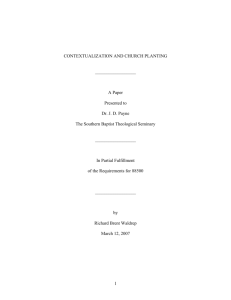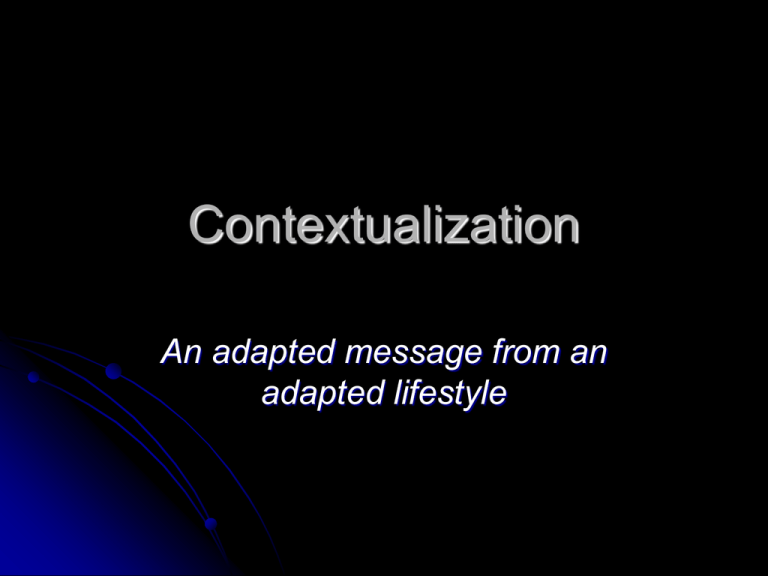
Contextualization
An adapted message from an
adapted lifestyle
Major Concept
Form
Function
In Translations: Which is
inspired:
words or meaning?
2
Definition
“Attempts to communicate the Gospel in
word and deed and to establish the church
in ways that make sense to people within
their local cultural context, presenting
Christianity in such a way that it meets
people’s deepest needs and penetrates
their worldview, thus allowing them to
follow Christ and remain within their own
culture.” Missiologist Darrell Whiteman
3
Definition
First used to express the tension between two realities:
Universal truths in the Bible
Diverse and ever-changing cultures
Contextualize means “to weave or join together”
Christian concern: What is the relationship between my
Christian faith and my culture?
Contextualization is the process of integration of these
two realities:
But there is a warning: Rom 12:1-2: Do not be
conformed to this present world, but be transformed by
the renewing of your mind, so that you may test and
approve what is the will of God– what is good and wellpleasing and perfect.
4
Accommodation to Transformation
The transition:
Adaptation (message, conversion, messenger)
Indigenization
Contextualization
Syncretism
Biblical basis:
Acts 15: How to incorporate Gentile lifestyle and
worship form
1 Cor 9:19-22: “I become all things to all men, that by
all means I might save some.”
5
Various Views
Moderate approach (Hasselgrave, Rommen
Radical approach (mostly from secular,
postmodern worldview of culture)
Maintain a biblical and theological pattern
Critically examine each point from a Scriptural context
View all cultures as equal
Intolerant and ethno-centric (imperialistic?) to claim
that one culture is better than another
Objectivity is outmoded in a postmodern view
Social-science premises undergird the modern
approach to contextualization
6
Missio Dei
All that God does in His task of establishing His kingdom
in all its fullness in all the world. While it includes what
the Church does, it is not limited to that, for God works
both in and out of the Church” – Moreau, 2000
Liberals let the world set the agenda: assumed it was
God’s purpose to justice through liberation from
oppression and corruption
Scriptures were not the issue, nor evangelism, discipleship and
church planting
History and contemporary events were to be exegeted to discern
where God was already at work bringing liberation and justice
Evangelicals have been reluctant to major in
contextualization until the 90’s.
Evangelicals “cherishes the ‘contextualization’ rubric
because it reminds us the Bible must be thought about,
translated into and preached in categories relevant to the
7
particular cultural context” (D. A. Carson)
Broad Definition
“Contextualization is the process whereby
representatives of a religious faith adapt the
forms and content of that faith in such a way as
to communicate and (usually commend it to the
minds and hearts of a new generation within
their own changing culture or to people with
other culture backgrounds (Hasselgrave, 1984)
Is the process of adapting the forms, content
and praxis of the Christian faith so as to
communicate it to the minds and hearts of
people with other cultural backgrounds.
The goal is the make the Christian faith
understandable
8
Characteristics of Contextualization
Is grounded in Scripture
1.
•
2.
3.
4.
Without this premise culture become dominant
resulting in relativism and syncretism (what is
meaningful to them rather than God’s standards)
Is Interdisciplinary in its approach to culture
(history, theology, anthropology, sociology,
linguistics, communications, psychology,
economics, politics, etc)
Is dynamic (never static) – Times of radical
cultural changes: urbanization, acculturation,
globalization)
Is holistic. If it does not integrate every part of
life, then the tendency is to be syncretistic
mixing what does integrate from culture,
tradition, and animistic views.
9
Characteristics of Contextualization
5.
6.
7.
Is aware of the impact of human
sinfulness on the process (what is
discerned as good and bad; our personal
agendas versus God’s)
Is both propositional and existential
(timeless truths and biblical concepts are
as important as how it is lived out daily)
Is a two-way process – Not one culture
telling another culture how to express
their faith – rather each side contributes.
10
Terms of Contextualization
Accommodation
Adaptation
Planting of a local church as an extension of the church universal
Accommodation allowed local cultural practices that were seen as neutral
or good to be incorporated into the local church’s life.
Based on Ricci (ancestors) and Nobili (lived like Brahmin holy man)
Vatican II has motivated greater accommodation.
Finding ways to express the gospel in forms and ideas that are familiar to
a culture so that it fits
Incorporating new meaning into indigenous words (John used logos, but
added new meaning), adaptation of liturgy (baptism and Lord’s supper),
changing church politics to fit culture
Indigenization (mid-1980s) – the “translatability” of the universal
Christian faith into forms and symbols of another culture (precedes
contextualization)
3-selfs (propagating, governing, financing) – Is this Western
individualizing a culture?
What about self-image (independent), self-functioning, self-giving, selftheologizing
11
Terms of Contextualization
Incarnation – an expatriate living and adapting to a local
culture
Though always limited by background and important goal
Enculturation – RCC term – a “dynamic relation
between the Christian message and culture—an
insertion of the Christian life into a culture” – the correct
way to live and share one’s faith in a culture.
Transformation – focuses on changing a society into
one that more adequately reflects the kingdom of God.
Disciples become advocates of social change
Some approaches put too much “weight on human capability
and not enough focus on human sin”
12
3-fold Cultural Contextualization
13
Dimension of Contextualization
1.
2.
3.
4.
5.
6.
7.
Doctrinal: expressions in religious form that targets a
particular theology
Stories or Myths: Worldview are formed by stories we
tell ourselves
Ethics: how we should live and behave
Social: how to organize ourselves in family and
community
Rituals: repeated symbolic actions: baptism,
communion, sermons, to greetings
Supernatural experiences: dreams, visions, signs,
miracles
Values and ideals expressed in art to construction
14
Vocabulary Problem
“Son of God” -- communicates notion of
God having sex with Mary: repugnant
Prefer using “Isa-al-Masih” – Jesus the
Messiah
They will incur the wrath of God if they say it
or believe it
“Allah”
This is a missionary generated controversy
All Bibles use “Allah”
15
Graphic of Muslim
Contextualization
Islamic
community
Christian community
C-1
C-2
C-3
C-4
C-5
C-6
16
C1 to C6 scale of
Muslim Contextualization
C1 Model: Traditional church using nonindigenous language
C2 Model: Traditional church using indigenous
language.
C3 Model: Contextualized Christ-centered
communities using Muslim’s language and nonreligiously indigenous cultural forms
C4 Model: Contextualized Christ-centered
communities using Muslim’s language and
biblically permissible cultural and Islamic forms.
17
C1 to C6 scale of
Muslim Contextualization
C5 Model: Christ-centered communities of
"Messianic Muslims" who have accepted
Jesus as Lord and Savior
C6 Model: Small Christ-centered
communities of secret or underground
believers isolated by extreme hostility,
usually individual believers but sometimes
in small groups.
18
Danger of Syncretism
Definition: “the unbiblical blending of true religion
with false”
The key is to keep biblical elements that are nonnegotiable and to discard unbiblical cultural or
religious elements.
Definition of syncretism in a particular setting
cannot be left in the hands of expatriate
missionaries
Missionaries must learn to trust that indigenous
peoples are able to discern God's leading and trust
God to develop and maintain biblically founded and
culturally relevant faith and praxis in each local
context
19
Danger of Syncretism
Hinduism incorporates all forms of belief and
worship without necessitating the selection or
elimination of any.
The Hindu is inclined to revere the divine in
every manifestation, whatever it may be, and is
doctrinally tolerant, leaving others" including
both Hindus and non-Hindus "whatever creed
and worship practices suit them best.
Some hold the theory that syncretism is a
temporary or transitory state that many churches
or individuals pass through, but eventually
mature and come to the knowledge of the truth.
20
Contemporary approaches
Advocates of C5 insider movements are
equally concerned about the dangers of
syncretism and lazy tolerance, but they
are also more concerned about true
Christ-centeredness than with conformity
to Gentile Christian traditions and doctrinal
codifications developed centuries after the
apostolic era
21
Contemporary approaches
A new contextualization trend among
missionaries is the use of indigenous
music rather than imported Western words
and styles.
Drawing from the insights of
ethnomusicology, missionaries are using
local music forms to both strengthen new
Christians in their faith and to reach out to
unbelievers
22

